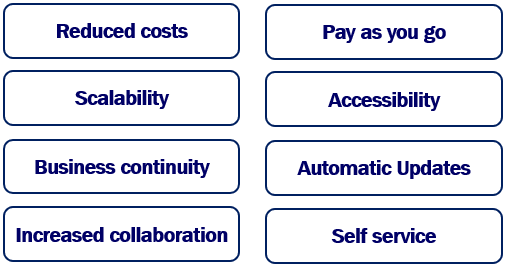Benefits of cloud computing
These days cloud is everywhere. So in this video, we will understand why cloud? What are the benefits or advantages it offers.

Reduced IT costs
One of the main benefits of moving to cloud is reduced IT costs.
If I have a business application and want to make it available online for users. Prior to cloud computing came into existence, oraganisations had to procure a physical server and all the related infrastructure to host the application. Servers are expensive, and there you go, organisations are faced with a large initial capex (i.e capital expdenditure).
It does not stop there. We need a server room and that needs to be secured. Setup and configure the server. Connect it to UPS and network. Make sure proper cooling system is in place. Install the server operating system, anti virus software, Database server, and, any other dependencies your business application might have like .NET framework, a web server like IIS for example. All this is the initial setup.
It does not stop here either. We need to keep these servers up and running i.e maintain them in good health. If there is an update or a security patch available, that needs to downloaded and installed. If there is a hardware failure, power failure, natural disaster or some other crisis, again we are responsible for replacing that failed hardware. What about database backups, disaster recovery, failover systems, the list, goes on. We need specialised IT workforce both for the initial setup and ongoing maintenance there on. So, the point that I am trying to make is organisations are faced with a huge opex i.e operating expenses which are every month usually.
Moving to cloud reduces both capex and opex. Organisations no longer have to spend huge amounts of money on physical servers, related IT infrastructure, specialised IT workforce, and server rooms or data center. We instead use the cloud infrastructure and pay a monthly fee for the resources and services we use.
Pay as you go
With cloud, it's pay-as-you-go, meaning, you only pay for what you use. It's like your utility bills, electricity or water bill. If there is lot of demand for your application and you use lot of cloud resources like storage, computing power etc, you pay more. You use them less, you pay less. So, the bottom line is, cloud resources are metered and you only pay for what you use.
Scalability
Cloud provides lot of scalability and flexibility options. May be you are launching a new business or product line and you need more cloud resources. You can scale up cloud resources like memory, processing power, storage etc, with just a click of a button. You can even automate this by setting threshold limits. For example, if 90% of the existing storage capacity is reached, add another 100 GB to the storage. You can do the opposite as well. If you are not using the resources, you can scale them down. Again, even for scaling down, you can set threshold limits and automate. With cloud, we will never run out of resources. When you need more power, scale up and when you don't, scale down. You no longer, have the burden of purchasing and installing that expensive upgrades yourself. Your cloud service provider like Azure or Amazon web services, handles this for you.
Accessibility
Cloud-based applications, services and data can be accessed from virtually anywhere and anytime. Home, office, while on holiday or in commute. All you really need is an internet-connected device.
Business Continuity
If you have your data stored on your own on-premise server, and, if there's a hardware failure, power failure or other crisis, your data is gone. Without data it is extremely difficult to run the business. The fact is, no data no business. On the other hand if you have data stored in the cloud, hardware failure, power failure, natural disaster or other crisis do not result in data loss because of networked backups.
Automatic Updates
If you have your services and applications on-premise, you are responsible for downloading, and installing software updates and security patches which is not only tedious but also time consuming. On the other hand, if you are using cloud, security patches and updates are installed automatically, off-sight by the service provider. You just to have to pay a small monthly fee. You don't have to worry about rolling out those updates and patches. Instead you can use that time to focus on what matters to the business.
Increased collaboration
With cloud it's very easy for teams and team members to access, edit and share files anytime and from anywhere. There is no longer the need to send documents and spreadsheets in email. It's all in the cloud and everyone who want to have access has access. So teams are able to better collaborate and work together.
Self service
Most of the resources and services cloud provide can be self serviced, meaning with a little bit of learning curve most people can easily procure, configure and use cloud resources and services. For example, if you need a server to host your business application, there is no need to consult IT experts to determine how big and fast the server has to be. With just a few clicks you can very easily procure a virtual machine from the cloud and host your application. If you need more processing power, you scale up and you don't need as much, you scale down, again with a few simple clicks. You will see how easy it is to create VMs, containers, scale resources up and down etc in our upcoming videos.
© 2020 Pragimtech. All Rights Reserved.

